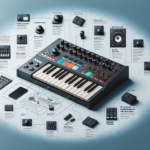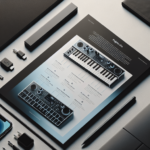Akai MPK225: Comprehensive Guide to Features, Setup, and Performance

Introduction
The Akai MPK225 is a versatile MIDI controller designed to meet the needs of both novice and professional musicians. This compact yet powerful device is part of Akai’s renowned MPK series, known for its high-quality build and extensive feature set. Whether you’re a bedroom producer, a live performer, or a seasoned studio professional, the MPK225 offers a range of functionalities that can enhance your music production workflow.
Akai Professional has been a leading name in the music production industry for decades, known for its innovative and reliable products. The MPK series, in particular, has garnered a strong reputation for its robust build quality and user-friendly features.
Key Features Overview:
- 25 semi-weighted keys with aftertouch
- 8 backlit MPC pads with Note Repeat and Full Level
- 8 assignable control knobs
- 4 assignable faders
- Comprehensive transport controls
- Built-in arpeggiator
- Integration with major DAWs
Design and Build Quality
Physical Design
The Akai MPK225 features a sleek and compact design, making it an ideal choice for musicians with limited studio space. Measuring approximately 19.25 x 11.75 x 3.63 inches and weighing around 6.1 pounds, it is both portable and sturdy. The controller is constructed from high-quality plastic with a matte finish, giving it a professional look and feel.
Portability
Thanks to its compact size and lightweight design, the MPK225 is highly portable. It can easily fit into a backpack or a small gig bag, making it a convenient option for musicians on the go. Whether you’re heading to a live performance or a collaborative studio session, transporting the MPK225 is hassle-free.
Durability
The build quality of the MPK225 is impressive, with a robust construction that can withstand regular use. The semi-weighted keys and MPC pads are designed to endure heavy playing, while the knobs and faders offer a solid, tactile feel. Overall, the MPK225 is built to last, ensuring reliable performance over time.
Setup and Configuration
Initial Setup
Setting up the Akai MPK225 is straightforward. Follow these steps to get started:
- Unbox the controller and connect it to your computer using the provided USB cable.
- Power on the controller by pressing the power button.
- Ensure your computer recognizes the device. Most modern operating systems will automatically detect and install the necessary drivers.
Software Installation
To fully utilize the MPK225, you’ll need to install the included software package. This typically includes the Akai Pro MPC Essentials, Ableton Live Lite, and various virtual instruments. Follow these steps:
- Visit the Akai Professional website and navigate to the MPK225 product page.
- Download the software package and follow the on-screen instructions to install it on your computer.
- Register your product to access additional software and updates.
Compatibility
The Akai MPK225 is compatible with a wide range of operating systems and DAWs. Supported operating systems include Windows 7, 8, 10, and macOS 10.7 or later. The controller integrates seamlessly with popular DAWs such as Ableton Live, FL Studio, Logic Pro, and more.
Features and Functionality
Key Features
The MPK225 boasts a range of features designed to enhance your music production experience:
- Keys: 25 semi-weighted keys with aftertouch provide a responsive and expressive playing experience.
- Pads: 8 backlit MPC pads with Note Repeat and Full Level functions, ideal for drum programming and triggering samples.
- Knobs and Faders: 8 assignable control knobs and 4 faders allow for precise control over your DAW and virtual instruments.
- Transport Controls: Dedicated transport buttons for play, stop, record, and more streamline your workflow.
- Arpeggiator: A built-in arpeggiator with adjustable parameters adds creative possibilities to your compositions.
Customizability
The MPK225 offers extensive customization options, allowing you to tailor the controller to your specific needs. Users can easily assign MIDI functions to the pads, knobs, and faders using the included software editor. This flexibility makes it easy to create personalized setups for different projects and performance scenarios.
Unique Functions
One of the standout features of the MPK225 is its integration with Akai’s MPC workflow. The Note Repeat and Full Level functions, combined with the responsive MPC pads, make it an excellent choice for beatmakers and producers who rely on the MPC workflow. Additionally, the built-in arpeggiator and aftertouch capabilities add depth and expressiveness to your performances.
Integration with DAWs
The MPK225 integrates seamlessly with major DAWs, offering pre-mapped controls for popular software like Ableton Live, FL Studio, and Logic Pro. This ensures a smooth and intuitive workflow, allowing you to focus on your creativity rather than technical setup. The controller also supports MIDI mapping, enabling you to customize the controls to suit your preferred DAW.
Advanced Features
In addition to its core features, the MPK225 offers several advanced functionalities:
- Aftertouch: The semi-weighted keys with aftertouch provide additional expressiveness, allowing for dynamic control over your virtual instruments.
- Arpeggiator: The built-in arpeggiator offers adjustable parameters such as tempo, gate, and swing, enabling you to create intricate patterns and sequences.
- Chord Modes: The controller includes various chord modes, making it easy to play complex chords with a single key press.
Performance
Latency and Responsiveness
The MPK225 excels in terms of latency and responsiveness. The semi-weighted keys and MPC pads offer a tactile and responsive feel, ensuring accurate and expressive performances. The controller’s low-latency performance makes it suitable for both studio recording and live performances.
Real-World Usage
In practical scenarios, the MPK225 performs admirably. Whether you’re using it for beatmaking, composing melodies, or controlling your DAW, the controller offers a seamless and intuitive experience. Its compact size and portability make it a versatile tool for both studio and live settings.
User Experience
User feedback for the MPK225 is generally positive, with many praising its build quality, feature set, and ease of use. The controller’s integration with major DAWs and customizable controls are frequently highlighted as standout features. Overall, the MPK225 offers a satisfying user experience for musicians of all skill levels.
Applications and Use Cases
Beginner vs. Professional Use
The MPK225 is suitable for both beginners and professionals. Its user-friendly interface and pre-mapped controls make it accessible for newcomers, while its advanced features and customization options cater to the needs of experienced musicians.
Studio Use
In a studio environment, the MPK225 excels as a versatile MIDI controller. Its semi-weighted keys and MPC pads are ideal for composing melodies, programming drums, and controlling virtual instruments. The controller’s integration with major DAWs streamlines the production process, making it a valuable tool for music producers and recording artists.
Live Performance
The MPK225 is also well-suited for live performances. Its compact size and portability make it easy to transport, while its responsive keys and pads ensure accurate and expressive performances. The built-in arpeggiator and chord modes add creative possibilities to live sets, making it a versatile choice for performing musicians.
Specific Genres
The MPK225 excels in various music genres, including EDM, hip-hop, and electronic music. Its MPC pads and Note Repeat function are particularly useful for beatmakers and producers in these genres. However, its versatile feature set makes it suitable for a wide range of musical styles, from classical to contemporary.
Pros and Cons
Pros:
- Compact and portable design
- High-quality build and durable construction
- Responsive semi-weighted keys with aftertouch
- Versatile MPC pads with Note Repeat and Full Level
- Extensive customization options
- Seamless integration with major DAWs
- Advanced features like arpeggiator and chord modes
Cons:
- Limited number of keys (25) may not be sufficient for some users
- Learning curve for beginners unfamiliar with MIDI controllers
- Some users may find the pads too small for finger drumming
Common Issues and Troubleshooting
Known Issues
While the MPK225 is generally well-received, some users have reported common issues such as:
- Occasional connectivity problems with certain DAWs
- Inconsistent pad sensitivity
- Difficulty in setting up MIDI mappings
Troubleshooting Tips
If you encounter any issues with the MPK225, try the following troubleshooting tips:
- Ensure your software and drivers are up to date.
- Check your USB connections and try using a different USB port.
- Consult the user manual for guidance on MIDI mapping and configuration.
- Reach out to Akai Professional’s customer support for assistance.
Customer Support
Akai Professional offers reliable customer support for the MPK225. Users can access online resources such as user manuals, FAQs, and video tutorials on the Akai website. Additionally, the brand provides email and phone support for more personalized assistance.
Comparisons with Similar Controllers
Competitor Comparison
When compared to similar MIDI controllers from other brands, the MPK225 holds its own. Competitors such as the Novation Launchkey 25 and the Arturia MiniLab MkII offer similar features, but the MPK225 stands out with its semi-weighted keys, MPC pads, and robust build quality.
Feature Comparison
In terms of features, the MPK225 offers a comprehensive set of controls, including assignable knobs, faders, and transport buttons. While some competitors may offer more keys or additional pads, the MPK225’s advanced features like aftertouch and arpeggiator give it an edge in terms of versatility and expressiveness.
Conclusion
Summary
The Akai MPK225 is a versatile and reliable MIDI controller that caters to the needs of both beginners and professionals. Its compact design, high-quality build, and extensive feature set make it a valuable tool for music production and live performances.
Who Should Buy This?
The MPK225 is ideal for musicians who need a portable and versatile MIDI controller. Whether you’re a beatmaker, producer, or live performer, the MPK225 offers a range of features that can enhance your creative workflow.
Final Thoughts
Overall, the Akai MPK225 is a well-rounded MIDI controller that delivers on its promises. Its combination of responsive keys, versatile pads, and advanced features make it a standout choice in its category. If you’re in the market for a reliable and feature-rich MIDI controller, the MPK225 is worth considering.
FAQ
Is the Akai MPK225 compatible with my DAW?
The MPK225 is compatible with most major DAWs, including Ableton Live, FL Studio, Logic Pro, and more. It also supports MIDI mapping for custom configurations.
Does the MPK225 require external power?
No, the MPK225 is USB-powered, making it easy to set up and use with your computer.
Can I use the MPK225 with my iPad?
Yes, the MPK225 can be used with an iPad using a compatible USB adapter. However, some features may require additional software or apps.
How do I update the firmware on my MPK225?
Firmware updates can be downloaded from the Akai Professional website. Follow the provided instructions to update your controller’s firmware.
What is aftertouch, and how does it work on the MPK225?
Aftertouch is a feature that allows you to add expressive control to your playing by applying pressure to the keys after they have been pressed. The MPK225’s semi-weighted keys support aftertouch, enabling dynamic control over your virtual instruments.
Where to Buy
The Akai MPK225 is available for purchase from various retailers, including major music equipment stores and online marketplaces. Some of the well-known retailers include Guitar Center, Sweetwater, and Amazon. Be sure to check for the best prices and available bundles to get the most value out of your purchase.




